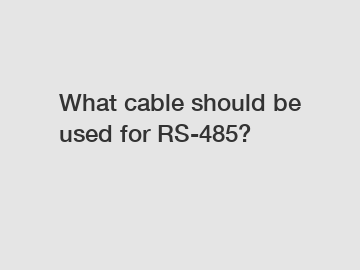What cable should be used for RS-485?
What cable should be used for RS-485? RS-485 is a popular communication standard in industrial automation and control systems. When it comes to selecting the appropriate cable for RS-485, it is crucial to consider factors such as noise immunity, impedance matching, and distance requirements.
The most commonly used cable for RS-485 is twisted-pair cable, with shielded and unshielded options available. Twisted-pair cable consists of two conductors twisted together, which helps to minimize the impact of electromagnetic interference (EMI) and radio frequency interference (RFI) on the signal. The twisting of the conductors helps in canceling out any induced noise that may affect the transmission quality.
For enhanced noise immunity, shielded twisted-pair (STP) cable is recommended. STP has an additional layer of insulation, known as a shield, which surrounds the twisted pair conductors. This shield helps to prevent external interference from affecting the transmission. It is particularly beneficial in environments with high levels of electromagnetic interference, such as industrial settings.

On the other hand, unshielded twisted-pair (UTP) cable, which does not have an additional shield, is suitable for applications with lower levels of noise interference. UTP is commonly used in office environments where EMI and RFI levels are comparatively low.
In terms of impedance matching, it is essential to use cable with the correct characteristic impedance to ensure that the signal is not degraded. RS-485 typically requires a characteristic impedance of 120 ohms. Therefore, cables with a characteristic impedance close to this value, such as 100-ohm twisted-pair cable, are commonly used.
Another critical aspect to consider is the distance requirement. RS-485 is capable of long-distance communication, typically up to 1200 meters. However, the cable's transmission capabilities can be affected by factors such as cable length and baud rate. It is advisable to consult the RS-485 specifications and ensure that the selected cable can support the required distance without signal degradation.
In conclusion, the ideal cable for RS-485 should be a twisted-pair cable, either shielded or unshielded, depending on the level of noise interference in the environment. The cable should have a characteristic impedance close to 120 ohms and be capable of supporting the required transmission distance. By carefully selecting the appropriate cable, the reliability and performance of RS-485 communication can be optimized, ensuring smooth and error-free data transmission in industrial automation and control systems.
Are you interested in learning more about netsure 531 a41, netsure power system, precision air conditioner design? Contact us today to secure an expert consultation!

Comments